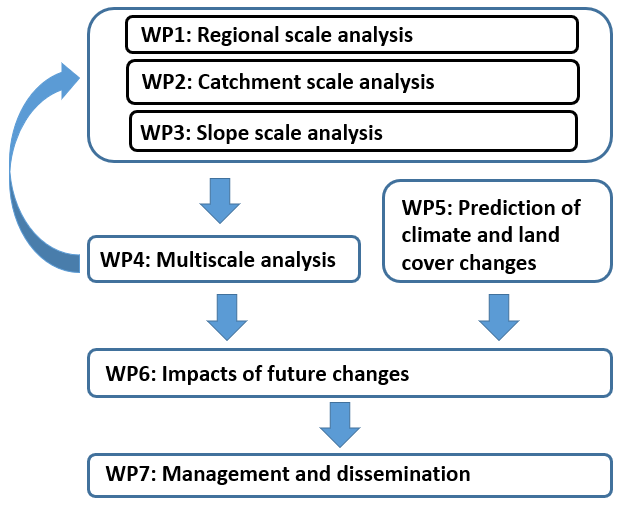General workplan (work packages)

WP1: Regional scale analysis
This WP aims to analyse and quantify the soil erosion rate at regional scale using the Upper Llobregat River basin as study and test area. Multiple geomatic techniques are applied to determine historic sediment yield and results are compared with recent observation of siltation at a selected water reservoir. All these data will be used to calibrate, assess and validate the existing and newly developed regional soil erosion model.
WP2: Catchment scale analysis
This WP deals with the quantitative analysis of soil erosion and sediment yield at first-order catchment scale. To account for the influence of the soil type, the investigation mainly focusses on two basins. One site is the Rebaixader catchment (Upper Noguera Ribagorçana River basin, South Central Pyrenees); which is a torrential basin with a coarse-grained soil. The site is monitored since 2009 for the research on formation and propagation of torrential flows and that is regarded as a natural laboratory. The other (new) study basin is a badland catchment close to Saldes (Upper Llobregat River basin, in the Pre-Pyrenees) in which the soil is a silty-clay regolith resulting from weathering of Garumnian shales.
WP3: Slope scale analysis
This WP aims to analyze and quantify the soil erosion rate at talus slope scale, which approximately refer to areas covering 1 to 100 m2. The WP includes field investigation plots at three sites (Saldes, Rebaixader and Cercs), at the existing experimental embankment (at UPC_Agrópolis) and the laboratory tests. In all cases, the instrumentation placed will be used to monitor rainfall (energy), soil moisture, runoff and the eroded material. In addition, meteorological variables will be measured (in situ) or mimicked (in laboratory). All these data will be used to calibrate, assess and validate the existing and newly developed soil erosion models at slope scale (input from WP4).
WP4: Multiscale analysis
WP4 contains the numerical activities to be carried out for the development of a multiscale integrated model for slope erosion. The final model is conceived as a tool immersed in a spatially reference database and driven by heuristic rules allowing for different analyses according to the scale of analysis: deterministic at slope scale, physically-based stochastic at regional scale and mixed upscaled deterministic/downscaled stochastic at catchment scale. The final model is validated by comparison with field and laboratory data obtained at different scale in WP1, WP2 and WP3.
WP5: Prediction of climate and land cover changes
This WP focuses on the future projections of climate conditions and land use and land cover (LULC). Future climate conditions will be taken from existing regional climate models and specific scenarios. In contrast, future LULC conditions will be modelled. The model will be calibrated in the ULR basin and then used to predict future conditions in the same and also other basins in the Pyrenees.The objective of this WP is to obtain a projection of LULC and climate conditions until 2100 taking into account the existing models of climate change.
WP6: Impacts of future changes
This WP focuses on the impacts of the future LULC as well as climate changes on soil erosion in steep slopes. It includes the inputs all the previous work packages, but is directly linked with WP4 and WP5 in order to determine the soil erosion under different climate and LULC scenarios. The WP mainly deals with regional scale analysis, but also catchment and slope scale will be investigated.The overall objective of this WP is to merge all the outcomes of the previous WPs to quantify the soil erosion up to 2100 under different scenarios of LULC and climate changes.
WP7: Management and dissemination
This work package will be active throughout the project and will ensure on one side the efficient coordination of all the participating persons/institutions. On the other side, special attention will be driven to the dissemination actions and the knowledge transfer to society. Another important goal of this WP is the transference of the results to the scientific community and the EPOs involved. This WP will strongly benefit from the two experts in scientific communications.
Share: